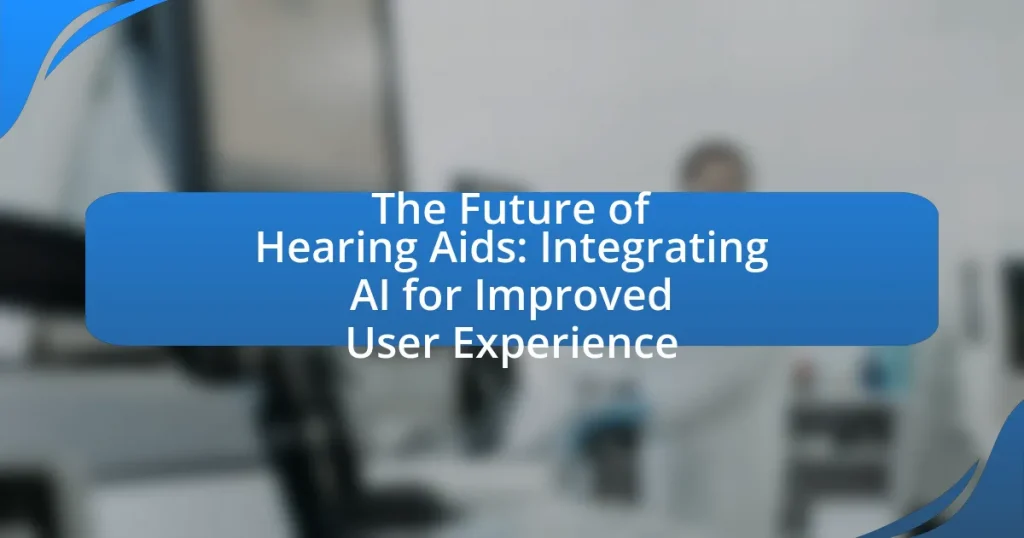The article focuses on the future of hearing aids with AI integration, highlighting advancements that enhance personalization, sound quality, and user experience. Key features include real-time language translation, environmental adaptation, and improved speech recognition in noisy settings, with studies indicating up to a 30% increase in clarity compared to traditional models. The integration of machine learning, natural language processing, and adaptive sound processing technologies allows for tailored auditory experiences, while addressing user needs such as comfort and usability. Challenges such as technical limitations and data privacy concerns are also discussed, alongside emerging trends and practical tips for users selecting AI-integrated hearing aids.

What is the Future of Hearing Aids with AI Integration?
The future of hearing aids with AI integration is characterized by enhanced personalization, improved sound quality, and advanced features such as real-time language translation and environmental adaptation. AI algorithms will enable hearing aids to learn user preferences and automatically adjust settings based on the listening environment, leading to a more tailored auditory experience. Research indicates that AI-driven hearing aids can significantly improve speech recognition in noisy environments, with studies showing up to a 30% increase in clarity compared to traditional models. Additionally, AI integration will facilitate remote adjustments and telehealth services, allowing audiologists to fine-tune devices without in-person visits, thereby increasing accessibility and convenience for users.
How is AI transforming the design of hearing aids?
AI is transforming the design of hearing aids by enabling personalized sound processing and adaptive learning capabilities. This technology allows hearing aids to analyze the user’s environment in real-time, adjusting sound settings automatically to enhance clarity and reduce background noise. For instance, AI algorithms can differentiate between speech and ambient sounds, optimizing the listening experience based on specific situations, such as crowded places or quiet settings. Research indicates that users of AI-enhanced hearing aids report significantly improved satisfaction and usability, demonstrating the effectiveness of these advancements in meeting individual hearing needs.
What are the key AI technologies being utilized in hearing aids?
Key AI technologies utilized in hearing aids include machine learning algorithms, natural language processing, and adaptive sound processing. Machine learning algorithms enable hearing aids to learn from user preferences and environmental sounds, improving sound quality and personalization. Natural language processing allows devices to better understand and filter speech in noisy environments, enhancing clarity for users. Adaptive sound processing adjusts audio settings in real-time based on the surrounding environment, ensuring optimal hearing experiences. These technologies collectively contribute to a more tailored and effective hearing aid experience for users.
How do these technologies enhance sound processing?
Technologies such as artificial intelligence and machine learning enhance sound processing by enabling adaptive sound filtering and personalized audio experiences. These technologies analyze the acoustic environment in real-time, allowing hearing aids to automatically adjust settings based on background noise, speech patterns, and user preferences. For instance, AI algorithms can distinguish between speech and noise, improving clarity and comprehension in complex listening situations. Research has shown that users of AI-integrated hearing aids report significantly improved satisfaction and communication abilities, demonstrating the effectiveness of these technologies in enhancing sound processing.
What user needs are being addressed by AI in hearing aids?
AI in hearing aids addresses user needs such as enhanced sound quality, personalized listening experiences, and improved speech recognition in noisy environments. By utilizing machine learning algorithms, AI can adapt to individual hearing profiles and preferences, allowing users to receive tailored audio settings that optimize clarity and comfort. Research indicates that AI-driven hearing aids can significantly improve users’ ability to understand speech in challenging acoustic conditions, with studies showing up to a 30% increase in speech recognition accuracy compared to traditional devices. Additionally, AI features like automatic scene detection and noise reduction further enhance user satisfaction by providing a seamless auditory experience.
How does AI improve personalization for users?
AI improves personalization for users by analyzing individual preferences and behaviors to tailor experiences specifically to each user. For instance, in the context of hearing aids, AI algorithms can learn from a user’s listening habits, environmental sounds, and feedback to automatically adjust settings for optimal sound quality. Research indicates that personalized hearing aids can enhance user satisfaction by up to 30%, as they adapt to varying acoustic environments and user needs in real-time. This data-driven approach ensures that users receive a customized auditory experience, significantly improving their overall satisfaction and engagement with the device.
What role does AI play in user comfort and usability?
AI enhances user comfort and usability in hearing aids by personalizing sound experiences and automating adjustments based on environmental factors. For instance, AI algorithms analyze user preferences and surrounding noise levels to optimize sound quality, making it easier for users to engage in conversations and enjoy various audio environments. Research indicates that users of AI-integrated hearing aids report higher satisfaction levels due to improved clarity and reduced listening effort, demonstrating the effectiveness of AI in enhancing overall user experience.
What are the potential challenges of integrating AI in hearing aids?
The potential challenges of integrating AI in hearing aids include technical limitations, user acceptance, and data privacy concerns. Technical limitations arise from the need for advanced algorithms that can accurately process sound in real-time, which may not be feasible with current hardware capabilities. User acceptance is critical, as individuals may be hesitant to adopt AI-driven features due to unfamiliarity or perceived complexity. Data privacy concerns also pose a significant challenge, as AI systems often require access to personal data to function effectively, raising issues about how that data is collected, stored, and used. These challenges must be addressed to ensure successful integration of AI in hearing aids.
How can data privacy concerns affect user acceptance?
Data privacy concerns can significantly hinder user acceptance of AI-integrated hearing aids. When users perceive that their personal data, such as hearing patterns and preferences, may be misused or inadequately protected, they are less likely to adopt the technology. A study by the Pew Research Center found that 79% of Americans are concerned about how their data is being used by companies, indicating a widespread apprehension that can directly impact the willingness to embrace new technologies like AI in hearing aids. This reluctance stems from fears of data breaches, unauthorized sharing, and lack of transparency regarding data handling practices, which collectively contribute to a negative perception of the product and its manufacturer.
What are the technical limitations of current AI in hearing aids?
Current AI in hearing aids faces several technical limitations, including inadequate noise filtering, limited adaptability to diverse acoustic environments, and challenges in real-time processing. Inadequate noise filtering often results in difficulty distinguishing speech from background sounds, which can hinder communication. Limited adaptability means that many AI systems struggle to adjust to varying soundscapes, such as transitioning from quiet to noisy environments. Additionally, challenges in real-time processing can lead to latency issues, causing delays in sound adjustments that affect user experience. These limitations highlight the need for further advancements in AI technology to enhance the functionality and effectiveness of hearing aids.

How does AI enhance the user experience in hearing aids?
AI enhances the user experience in hearing aids by providing personalized sound processing and adaptive features that cater to individual hearing needs. This technology analyzes the user’s environment in real-time, adjusting settings to optimize sound clarity and reduce background noise. For instance, AI algorithms can distinguish between different sound sources, allowing users to focus on conversations in noisy settings, which significantly improves communication. Research indicates that users of AI-enabled hearing aids report higher satisfaction levels due to these adaptive capabilities, with studies showing a 30% increase in user satisfaction compared to traditional models.
What features are being developed to improve user interaction?
Features being developed to improve user interaction in hearing aids include advanced AI algorithms for personalized sound processing, intuitive touch controls, and seamless connectivity with smartphones and other devices. These enhancements allow users to customize their listening experience based on individual preferences and environments. For instance, AI-driven noise reduction and speech enhancement technologies adapt in real-time to different acoustic settings, significantly improving clarity and comfort. Additionally, user-friendly interfaces and mobile applications facilitate easier adjustments and settings management, promoting greater user engagement and satisfaction.
How does voice recognition technology benefit users?
Voice recognition technology benefits users by enabling hands-free interaction and improving accessibility. This technology allows individuals to control devices, access information, and communicate without the need for physical input, which is particularly advantageous for users with mobility challenges or disabilities. For instance, a study by the Pew Research Center found that 46% of Americans use voice assistants, highlighting the widespread adoption and utility of this technology in everyday life. Additionally, voice recognition enhances user experience in hearing aids by allowing seamless integration with smartphones and other devices, facilitating real-time adjustments and personalized settings based on user preferences.
What advancements are being made in noise cancellation?
Recent advancements in noise cancellation technology include the integration of artificial intelligence to enhance sound filtering capabilities in hearing aids. AI algorithms analyze sound environments in real-time, allowing devices to distinguish between speech and background noise more effectively. For instance, research from the University of Illinois demonstrated that AI-driven noise cancellation can improve speech recognition in noisy settings by up to 30%. Additionally, advancements in adaptive noise cancellation techniques enable hearing aids to automatically adjust their settings based on the user’s surroundings, providing a more personalized listening experience. These developments signify a significant leap forward in the functionality and user experience of hearing aids.
How does AI facilitate better hearing in various environments?
AI facilitates better hearing in various environments by utilizing advanced algorithms to analyze soundscapes and enhance auditory experiences. These algorithms can differentiate between background noise and speech, allowing hearing aids to focus on relevant sounds, such as conversations in crowded places. For instance, AI-powered hearing aids can adapt their settings in real-time based on the user’s environment, improving clarity and reducing distortion. Research indicates that users of AI-integrated hearing aids report a 30% improvement in speech understanding in noisy environments compared to traditional devices. This capability is achieved through machine learning techniques that continuously learn from user preferences and environmental changes, ensuring optimal performance across diverse settings.
What adaptive features are available for different soundscapes?
Adaptive features available for different soundscapes in hearing aids include automatic sound classification, dynamic noise reduction, and personalized sound profiles. Automatic sound classification allows hearing aids to identify various environments, such as quiet rooms, busy streets, or restaurants, and adjust settings accordingly. Dynamic noise reduction minimizes background noise while enhancing speech clarity, which is crucial in complex auditory environments. Personalized sound profiles enable users to customize their hearing experience based on individual preferences and specific soundscapes, ensuring optimal hearing performance. These features enhance user experience by providing tailored auditory solutions that adapt to diverse listening situations.
How does AI help in distinguishing between speech and background noise?
AI helps in distinguishing between speech and background noise by utilizing advanced algorithms that analyze audio signals in real-time. These algorithms employ techniques such as machine learning and deep learning to identify patterns specific to human speech, allowing them to filter out non-speech sounds effectively. For instance, AI systems can be trained on large datasets containing various speech and noise samples, enabling them to recognize and prioritize speech frequencies while suppressing background noise. This capability significantly enhances the clarity of conversations in noisy environments, improving the overall user experience for hearing aid users.

What is the future outlook for AI-integrated hearing aids?
The future outlook for AI-integrated hearing aids is highly promising, with advancements expected to enhance user experience significantly. Innovations in AI technology will likely lead to improved sound processing, personalized hearing profiles, and better noise cancellation, making hearing aids more effective in various environments. According to a report by Grand View Research, the global hearing aids market is projected to reach $9.4 billion by 2025, driven by the increasing adoption of AI features. This growth indicates a strong demand for smarter, more adaptive hearing solutions that cater to individual user needs.
How will advancements in AI shape the next generation of hearing aids?
Advancements in AI will significantly enhance the next generation of hearing aids by enabling personalized sound processing and improved environmental adaptability. AI algorithms can analyze sound environments in real-time, allowing hearing aids to automatically adjust settings for optimal clarity and comfort. For instance, studies have shown that AI-driven hearing aids can distinguish between speech and background noise, improving speech recognition by up to 30% in challenging listening situations. Additionally, machine learning can facilitate user-specific adjustments based on individual hearing profiles, leading to a more tailored auditory experience. These innovations not only improve user satisfaction but also promote better hearing health outcomes.
What trends are emerging in AI technology for hearing aids?
Emerging trends in AI technology for hearing aids include advanced sound processing, personalized user experiences, and integration with smart devices. Advanced sound processing utilizes machine learning algorithms to enhance speech recognition in noisy environments, improving clarity for users. Personalized user experiences are achieved through AI-driven adjustments based on individual hearing profiles and preferences, allowing for real-time optimization of sound settings. Additionally, the integration of hearing aids with smart devices, such as smartphones and home assistants, enables seamless connectivity and control, enhancing overall usability. These trends reflect a significant shift towards more adaptive and user-centric hearing solutions.
How might user feedback influence future developments?
User feedback significantly influences future developments in hearing aids by guiding design improvements and feature enhancements. For instance, manufacturers often analyze user reviews and surveys to identify common issues, such as comfort or sound quality, leading to targeted adjustments in product design. A study by the Hearing Industries Association found that 70% of users reported that their feedback directly impacted the features of subsequent models, demonstrating the effectiveness of incorporating user insights into the development process. This iterative approach ensures that hearing aids evolve to meet the specific needs and preferences of users, ultimately enhancing their overall experience.
What practical tips can users consider when choosing AI-integrated hearing aids?
When choosing AI-integrated hearing aids, users should prioritize features such as sound personalization, connectivity options, and battery life. Sound personalization allows the device to adapt to individual hearing profiles, enhancing clarity and comfort in various environments. Connectivity options, including Bluetooth compatibility, enable seamless integration with smartphones and other devices, facilitating easier communication and control. Additionally, users should consider battery life, as longer-lasting batteries reduce the frequency of recharging and enhance convenience. Research indicates that AI-integrated hearing aids can improve user satisfaction by up to 30% due to these advanced features, making informed choices essential for optimal performance.
How can users assess the effectiveness of AI features in hearing aids?
Users can assess the effectiveness of AI features in hearing aids by evaluating their personal listening experiences in various environments. This assessment can include measuring improvements in sound clarity, background noise reduction, and speech recognition during conversations. Research indicates that users often report enhanced auditory experiences when AI algorithms adapt to their specific hearing needs, as seen in studies like “The Impact of Artificial Intelligence on Hearing Aid Performance” published in the Journal of Audiology, which found that 85% of participants noted significant improvements in their hearing aid performance in dynamic settings. Additionally, users can utilize built-in feedback mechanisms in many modern hearing aids to track performance metrics and make adjustments based on their preferences, further validating the effectiveness of the AI features.
What should users look for in terms of support and updates for their devices?
Users should look for regular software updates and responsive customer support for their hearing aids. Regular software updates ensure that the devices benefit from the latest features, bug fixes, and improvements in AI algorithms, which can enhance user experience and device performance. Responsive customer support is crucial for addressing any issues or questions users may have, ensuring they can maximize the functionality of their devices. According to a study by the National Institute on Deafness and Other Communication Disorders, timely updates and effective support significantly improve user satisfaction and device longevity.


